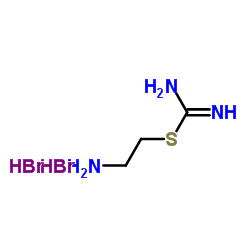S-(2-Aminoethyl)pseudothiourea dihydrobromide

S-(2-Aminoethyl)pseudothiourea dihydrobromide structure
|
Common Name | S-(2-Aminoethyl)pseudothiourea dihydrobromide | ||
|---|---|---|---|---|
| CAS Number | 56-10-0 | Molecular Weight | 281.013 | |
| Density | N/A | Boiling Point | 231.1ºC at 760mmHg | |
| Molecular Formula | C3H11Br2N3S | Melting Point | 190-196 °C(lit.) | |
| MSDS | Chinese USA | Flash Point | 93.6ºC | |
| Symbol |

GHS07 |
Signal Word | Warning | |
|
Chemical genetics reveals a complex functional ground state of neural stem cells.
Nat. Chem. Biol. 3(5) , 268-273, (2007) The identification of self-renewing and multipotent neural stem cells (NSCs) in the mammalian brain holds promise for the treatment of neurological diseases and has yielded new insight into brain cancer. However, the complete repertoire of signaling pathways ... |
|
|
Defects in mitochondrial efficiency and H2O2 emissions in obese women are restored to a lean phenotype with aerobic exercise training.
Diabetes 64 , 2104-15, (2015) The notion that mitochondria contribute to obesity-induced insulin resistance is highly debated. Therefore, we determined whether obese (BMI 33 kg/m(2)), insulin-resistant women with polycystic ovary syndrome had aberrant skeletal muscle mitochondrial physiol... |
|
|
How 'arm-twisting' by the inducer triggers activation of the MalT transcription factor, a typical signal transduction ATPase with numerous domains (STAND).
Nucleic Acids Res. 43 , 3089-99, (2015) Signal transduction ATPases with numerous domains (STAND) get activated through inducer-dependent assembly into multimeric platforms. This switch relies on the conversion of their nucleotide-binding oligomerization domain (NOD) from a closed, ADP-bound form t... |
|
|
N(6)-(3-methoxyl-4-hydroxybenzyl) adenine riboside induces sedative and hypnotic effects via GAD enzyme activation in mice.
Pharmacol. Biochem. Behav. 126 , 146-51, (2014) N(6)-(3-methoxyl-4-hydroxybenzyl) adenine riboside (B2) is an analog of N(6)-(4-hydroxybenzyl) adenine riboside (NHBA), which was originally isolated from Gastrodia elata Blume. Our laboratory has previously demonstrated that B2 can produce strong sedative an... |
|
|
Differential activity of NO synthase inhibitors as chemopreventive agents in a primary rat tracheal epithelial cell transformation system.
Neoplasia 4(4) , 332-6, (2002) A model to study the effectiveness of potential chemopreventive agents that inhibit neoplastic process by different mechanisms has been used to test the efficacy of seven nitric oxide synthase (NOS) inhibitors. Five selective inducible NOS (iNOS) inhibitors: ... |
|
|
The effects of intracisternal enzyme replacement versus sham treatment on central neuropathology in preclinical canine fucosidosis.
Orphanet J. Rare Dis. 10 , 143, (2015) Fucosidosis results from lack of α-L-fucosidase activity, with accumulation of fucose-linked substrates in the nervous system and viscera leading to progressive motor and mental deterioration, and death. The naturally occurring dog model of fucosidosis was us... |
|
|
Certain S-substituted isothioureas not only inhibit NO synthase catalytic activity but also decrease translation and stability of inducible NO synthase protein.
Nitric Oxide 2(3) , 155-64, (1998) In an attempt to identify potent inhibitors of inducible (type II) NO synthase (iNOS) for use in cell culture systems, we found that two S-substituted isothioureas were very potent in cell culture but one such compound also interfered with the induction of NO... |
|
|
Pathophysiological role of nitric oxide in rat experimental colitis.
Int. J. Immunopharmacol. 19(11-12) , 669-76, (1997) Overproduction of nitric oxide (NO) by inducible nitric oxide synthase (iNOS) may contribute to the pathophysiology of ulcerative colitis. A 2,4,6-trinitrobenzenesulfonic acid sodium salt (TNBS) colitis model was established to examine the effect of selective... |
|
|
Radioprotective effects of quercetin and ethanolic extract of propolis in gamma-irradiated mice.
Arh. Hig. Rada Toksikol. 60(2) , 129-38, (2009) The aim of this study was to assess radioprotective effects of quercetin and the ethanolic extract of propolis (EEP) in CBA mice exposed to a single radiation dose 4 Gy (60Co). The mice were treated with 100 mg kg(-1) quercetin or EEP a day for three consecut... |
|
|
Selective inhibition of inducible nitric oxide synthase maintains haemodynamic stability without untoward consequences for hepatic function or morphology.
Eur. J. Surg. 165(12) , 1167-74, (1999) To examine the effects of the inducible nitric oxide synthase inhibitor aminoethyl-isothiourea (AE-ITU) on haemodynamic measurements, and correlate these with hepatic morphology and function in a porcine model of endotoxaemia.Experimental study.15 juvenile pi... |